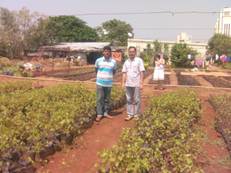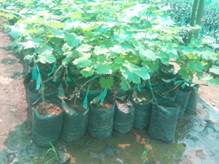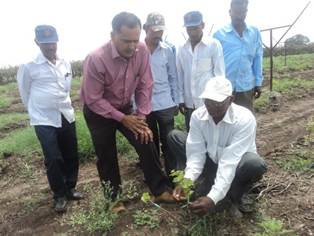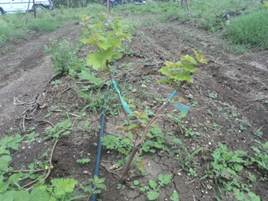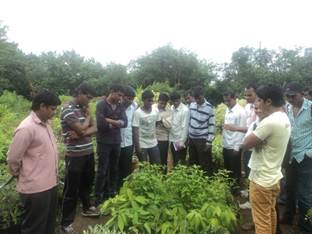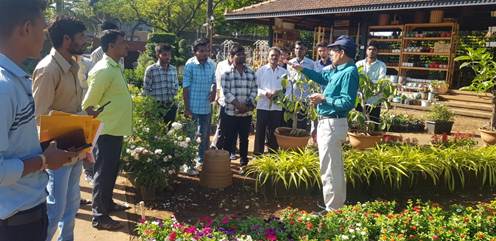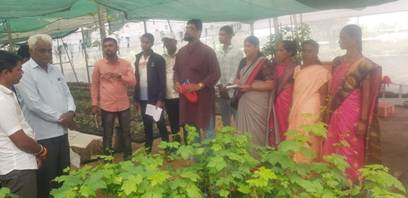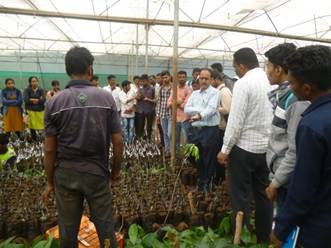Nashik is the most horticultural developing district of the state. Grape, Pomegranate, Guava, Tomato, Capsicum, Cabbage, Cauliflower, Chilli are the major fruits and vegetable crop grown in the district. Grape farmers are adopting improved techniques for plantation using grape rootstocks. But there was shortage of manpower for grafting. Krishi Vigyan Kendra, Nashik decided to engage unemployed rural youths in the services for income generation through trained them for horticulture nursery management and propagation methods.
The Western Ghat Zone of Nashik district, which is mostly tribal population with seasonal cultivation, had a heavy demand for mango Grafts Var. Kesar. Farmers are marginal, with small land holdings and limited source of irrigation. Mango plantation on sloppy, marginal land and farm bunds are found more effective to get assured income for long period. The Demand for quality mango grafts from local farmers was met by outside nurseries. To meet the demand KVK Nashik trained Rural youths and supported them to start small mango graft nurseries.
Traditionally, vegetable farmers raise nursery on soil beds, which causes heavy mortality due to disease infestation from soil and open climate. Rural youths and farmers are trained about modern hi-tech vegetable nursery raising under protected structure. Seedlings of vegetables are grown in small cells and transplanted to fields. This technique has many advantages compared to the traditional method, including less seed usage, higher survival rate, higher quality and uniformity of transplants, and earlier harvest.
After conducting a general survey of the satellite, focal, and adopted villages of the district, it was observed that the young generation is unemployed. Most of the youths have left school before completing secondary education, limiting their job opportunities. Most youths have very small land holdings with poor resources and seasonal farming, making it difficult to meet daily needs.
Surveying the need for quality planting material of major commercial horticulture crops revealed a great opportunity to train and engage unskilled & unemployed Rural Youths for an assured source of income. KVK, Nashik decided to train them in horticulture nursery management and propagation methods. Initially, a 15-30 days on-campus vocational training program was conducted. In the last 5 years, the training has been planned for a one-week duration as per demand.
About 15-20 needy & unemployed rural youths from different villages of the district were identified and actively participated in the training. From 2015 to 2024, a total of 231 Rural Youths have participated in the Horticulture Nursery Training.
| Sr. No. | Year | Male | Female | Total Participants |
|---|---|---|---|---|
| 01 | 2015 | 22 | - | 22 |
| 02 | 2016 | 22 | - | 22 |
| 03 | 2017 | 18 | 02 | 20 |
| 04 | 2018 | 18 | 01 | 18 |
| 05 | 2019 | 19 | 02 | 21 |
| 06 | 2020 | 21 | 01 | 22 |
| 07 | 2021 | 13 | 03 | 16 |
| 08 | 2022 | 29 | 05 | 34 |
| 09 | 2023 | 21 | - | 21 |
| 10 | 2024 | 34 | - | 34 |
| TOTAL | 214 | 17 | 231 | |
Knowledge testing of participants before and after the training showed significant improvement. Feedback from participants was positive and useful for future planning. Most participants were fully satisfied and acquired skills in grafting and seedling raising. Some started grapes nurseries, some took contracts for in-situ grafting of grapes rootstocks, and others decided to work as skilled gardeners in commercial nurseries.
Out of 231 participants, about 45-50 youths engaged in different horticulture nursery-based income-generating enterprises over the last 10 years.
| Sr. No. | Nursery Type | No of Units | Average No of Saplings/Grafts | Net Earnings (Rs.)/yr | Average Employment |
|---|---|---|---|---|---|
| 01 | Vegetable Nursery Units | 06 | 40 lacs saplings | 15 lacs | 65 |
| 02 | Fruit Nursery Units | 05 | 8,000 grafts annually | 10 lacs | 15 |
Additionally, 15 groups of rural youths (4-5 participants each) are engaged in commercially viable grafting contracts for grapes. With minimal investment (secateurs, budding knife), they have become highly skilled, grafting 300-400 plants a day. During the 45-50 day season (Sept-Oct), they earn Rs. 1000-1200 per day, totaling Rs. 18,000-22,000 per person per season. The survival rate of their grafts is over 90%, creating high demand from farmers.
There is a rising demand for quality grafts and vegetable seedlings, which increases the demand for trained rural youths. Due to growing interest from unemployed youths, there will be an expansion of nursery trainings. Key opportunities lie in:
The plan is to strengthen entrepreneurship in the nursery sector for sustainable livelihood and to use a Barcode and batch code system for seedling trays to trace variety, date of production, batch number, etc.
